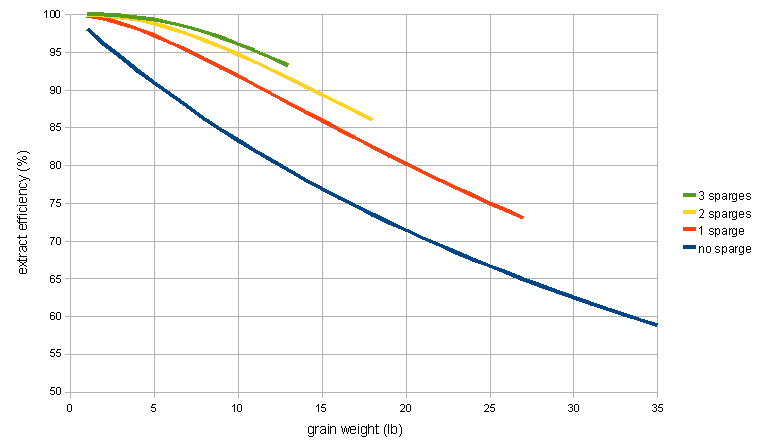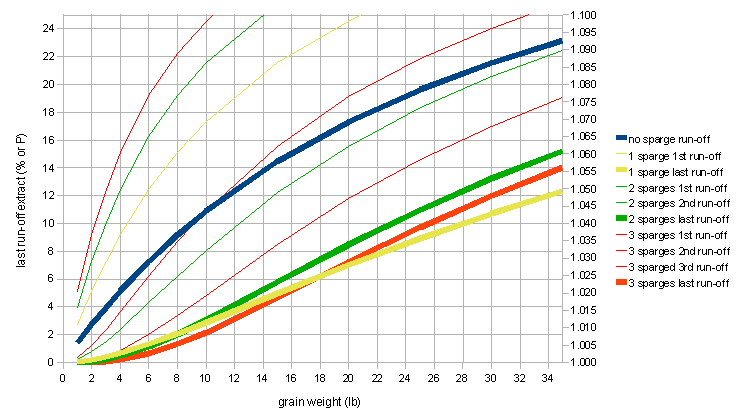explosivebeer
Well-Known Member
Chris Colby from Brew Your Own magazine wrote an article in the December 2007 issue about his new technique for reiterated mashing. It's a method to get high-gravity beers without excessively boiling down your wort or causing it to turn dark from the caramelization that occurs during a long boil. Basically, you do a primary mash, feed that wort into a fresh set of grains, and repeat if you want an even higher-gravity brew.
Anyway, I recently listened to him talk about his method on a Basic Brewing Podcast with James Spencer. I took some notes and thought I'd post them here as a reference for anyone who was curious about this method.
Reiterated Mashing w/ Chris Colby from BYO with James Spencer/Basic Brewing Podcast
The general idea is that you're using wort as mash liquor and concentrating the wort in mash tun instead of kettle.
3 typical ways to get high gravity (drawbacks in parenthesis)
1) add extract (cost)
2) add a lot of grain to the mash tun and boil down (time to boil, darkens color)
3) add a ton of grain and only take first runnings (bad efficiency)
Reiterative mashing gets a light-colored high-gravity beer, but is not very efficient.
Forming the recipe
Plan on 2-3 mashes with each mash size the same.
Decide on your target pre-boil kettle volume and work backwards.
About 10 lbs of grain for 6 gallons of wort is about right for a typical batch for most homebrewers. So do 10 lbs of grain for each mash and only take 1st runnings.
For a very high gravity brew, think about decreasing caramel and specialty malts since they tend to yield some unfermentable sugars and raise the final gravity. Big beers usually have enough unfermentable sugars.
You could add some flaked maize to keep alcohol level high but gravity lower.
After first mash (~20 minutes), transfer wort to second grain bed. Stir occasionally and give it time. It takes more time to mash with wort than with water. About an hour for wort mashing is right, stirring every 10-15 minutes or so.
Use a refractometer to see the increase in gravity. It should be nearly double after the second batch.
Actually put the grains in the kettle and scoop out after mashing? Pour back into mash tun and filter?
1st mash ~ 150 degrees
2nd mash ~ 140 degrees (with second batch of grains)
(if 2nd is final mash, leave low to get more fermentables; if it's the 2nd of 3, take it back up to 150)
In mashes leading up to the final mash, you don't need to worry about conversion, just dissolving and extracting.
Mash out and do a full recirculation.
A little bit of sparge water is added each time to account for grain absorbtion.
With this method it is possible to get a golden or even a straw color with high gravity.
Two mashes takes about three hours. Three mashes takes about 4.25 hours. (plus boil, cleanup, etc.)
Ultimately it probably takes about the same amount of time as boiling down a high gravity beer.
Make sure you have enough yeast (use a high-gravity full yeast cake if possible).
Aerate well, possibly multiple times.
Think about using yeast nutrients. The maximum amount recommended is the starting point.
Save 10% of wort (unaerated), add fresh yeast, then add to the mostly fermented batch to kick-start it.
Get close to the upper-range of yeast temperature to ensure maximum conversion.
Assuming 65% extraction efficiency and 75% attenuation, you'll end up with 9-10% ABV for 2 mashes, and 13-14% for 3 mashes.
You COULD think about using a champagne yeast towards the end, but it never seems to yield good results and is definitely not recommended. Beer yeast is more geared towards the types of fermentables in wort.
Chris experimented with this process by doing 3-gallon batches. That may be a good option for people who don't have a bigger mash tun or kettle.
The article gives two recipes for big lagers. (I don't actually have the article but someone else may be able to help with that.)
-------------------------------------
Anyway, it sounds like a very interesting process. I did a parti-gyle session last weekend and will probably try this the next time, using all the first runnings for a big, clear beer, and the seconds for another lighter option.
If you want to listen to the podcast, go here and scroll down to November 22nd, 2007: http://www.basicbrewing.com/index.php?page=radio
Anyway, I recently listened to him talk about his method on a Basic Brewing Podcast with James Spencer. I took some notes and thought I'd post them here as a reference for anyone who was curious about this method.
Reiterated Mashing w/ Chris Colby from BYO with James Spencer/Basic Brewing Podcast
The general idea is that you're using wort as mash liquor and concentrating the wort in mash tun instead of kettle.
3 typical ways to get high gravity (drawbacks in parenthesis)
1) add extract (cost)
2) add a lot of grain to the mash tun and boil down (time to boil, darkens color)
3) add a ton of grain and only take first runnings (bad efficiency)
Reiterative mashing gets a light-colored high-gravity beer, but is not very efficient.
Forming the recipe
Plan on 2-3 mashes with each mash size the same.
Decide on your target pre-boil kettle volume and work backwards.
About 10 lbs of grain for 6 gallons of wort is about right for a typical batch for most homebrewers. So do 10 lbs of grain for each mash and only take 1st runnings.
For a very high gravity brew, think about decreasing caramel and specialty malts since they tend to yield some unfermentable sugars and raise the final gravity. Big beers usually have enough unfermentable sugars.
You could add some flaked maize to keep alcohol level high but gravity lower.
After first mash (~20 minutes), transfer wort to second grain bed. Stir occasionally and give it time. It takes more time to mash with wort than with water. About an hour for wort mashing is right, stirring every 10-15 minutes or so.
Use a refractometer to see the increase in gravity. It should be nearly double after the second batch.
Actually put the grains in the kettle and scoop out after mashing? Pour back into mash tun and filter?
1st mash ~ 150 degrees
2nd mash ~ 140 degrees (with second batch of grains)
(if 2nd is final mash, leave low to get more fermentables; if it's the 2nd of 3, take it back up to 150)
In mashes leading up to the final mash, you don't need to worry about conversion, just dissolving and extracting.
Mash out and do a full recirculation.
A little bit of sparge water is added each time to account for grain absorbtion.
With this method it is possible to get a golden or even a straw color with high gravity.
Two mashes takes about three hours. Three mashes takes about 4.25 hours. (plus boil, cleanup, etc.)
Ultimately it probably takes about the same amount of time as boiling down a high gravity beer.
Make sure you have enough yeast (use a high-gravity full yeast cake if possible).
Aerate well, possibly multiple times.
Think about using yeast nutrients. The maximum amount recommended is the starting point.
Save 10% of wort (unaerated), add fresh yeast, then add to the mostly fermented batch to kick-start it.
Get close to the upper-range of yeast temperature to ensure maximum conversion.
Assuming 65% extraction efficiency and 75% attenuation, you'll end up with 9-10% ABV for 2 mashes, and 13-14% for 3 mashes.
You COULD think about using a champagne yeast towards the end, but it never seems to yield good results and is definitely not recommended. Beer yeast is more geared towards the types of fermentables in wort.
Chris experimented with this process by doing 3-gallon batches. That may be a good option for people who don't have a bigger mash tun or kettle.
The article gives two recipes for big lagers. (I don't actually have the article but someone else may be able to help with that.)
-------------------------------------
Anyway, it sounds like a very interesting process. I did a parti-gyle session last weekend and will probably try this the next time, using all the first runnings for a big, clear beer, and the seconds for another lighter option.
If you want to listen to the podcast, go here and scroll down to November 22nd, 2007: http://www.basicbrewing.com/index.php?page=radio









































![Craft A Brew - Safale S-04 Dry Yeast - Fermentis - English Ale Dry Yeast - For English and American Ales and Hard Apple Ciders - Ingredients for Home Brewing - Beer Making Supplies - [1 Pack]](https://m.media-amazon.com/images/I/41fVGNh6JfL._SL500_.jpg)


















 to show that my numbers match reality.
to show that my numbers match reality.